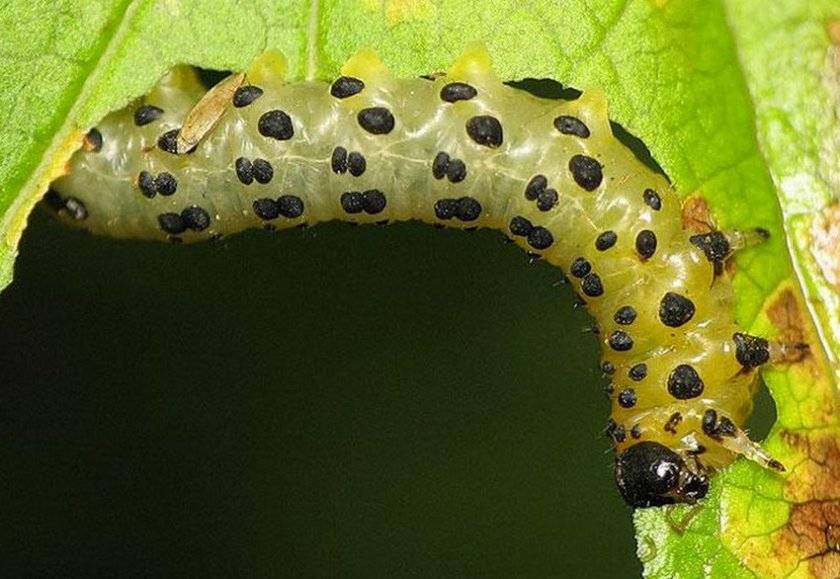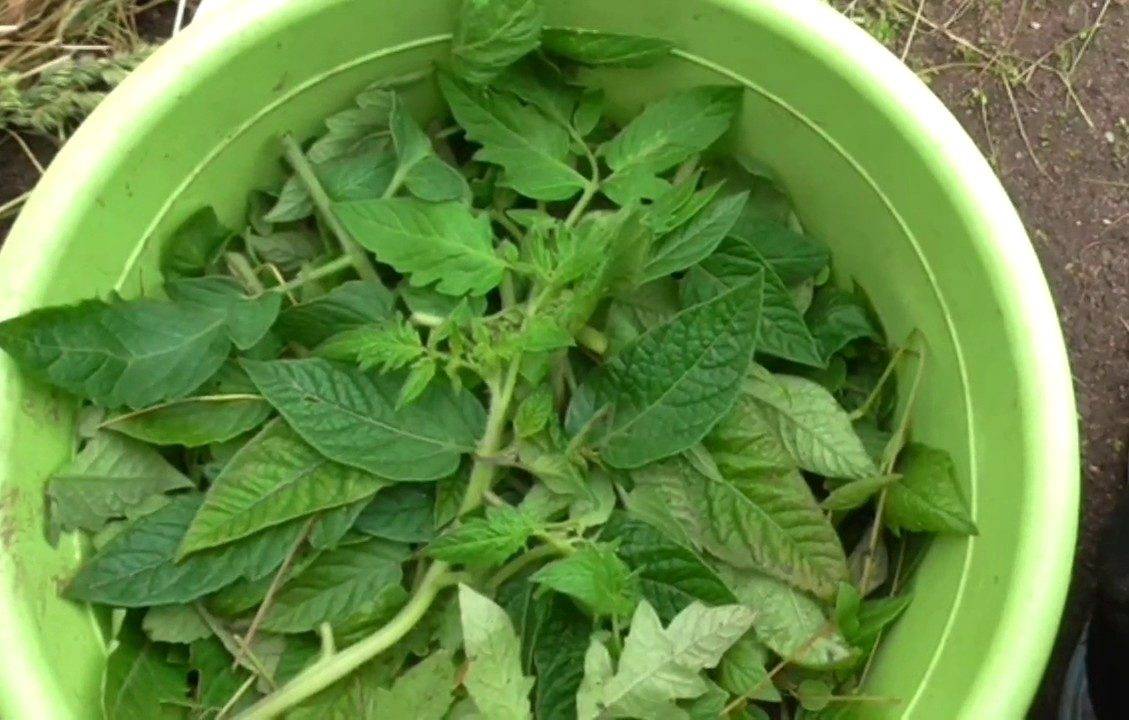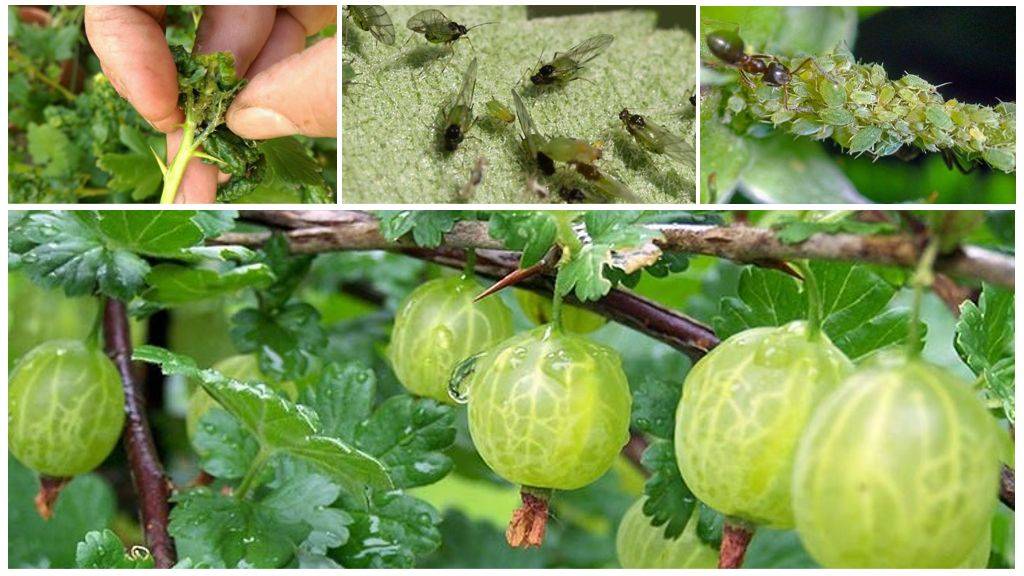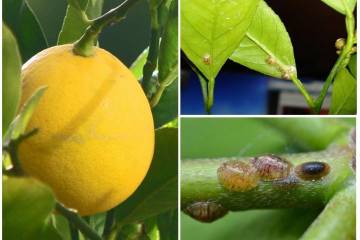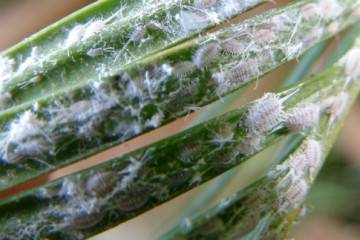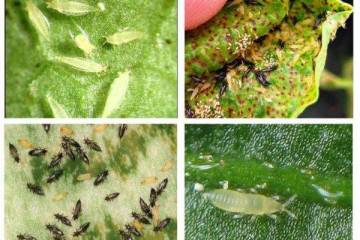Gooseberry caterpillars ate leaves, how to deal with pests
Content:
Gooseberries are rich in vitamins, and they can be used to make “royal” jam, amazing in its beauty and taste, which Alexander Pushkin himself loved. And in folk medicine, the plant is usually used as a laxative and diuretic. The abundance of useful properties has become the reason that bushes with thorny branches are found in a large number of summer cottages. But it also happens that the caterpillars on the gooseberry have eaten the leaves: how to deal with this scourge? There are many ways, from folk to professional.
Symptoms indicating that the plant has been attacked by pests
The gooseberry belongs to unpretentious garden crops, but it is not immune from a sudden attack of pests, primarily caterpillars. These tiny creatures do great harm, interfering with the natural development of the plant and reducing its yield. It is very important to notice the danger in time and begin to eliminate it.
The main signs signaling that the bush has been hit by malicious creatures:
- Pests are visible to the naked eye. It is quite easy to notice caterpillars, worms crawling on the leaves - these are the larvae of sawflies, butterflies. They are much more voracious and dangerous than adults.
- The leaf mass turns yellow.
- Leaves dry, curl up.
- The fruiting of the bush is markedly reduced.
- The appearance of the web indicates that the plant was attacked by a spider mite.
After the appearance of these signs, one should, without delay, begin to destroy the pests until their harm leads to the complete death of the crop.
Common pests on gooseberries and methods of dealing with them
There are several parasites that are peculiar only to gooseberries: gooseberry moth, gooseberry moth. There are also common pests of fruit and berry crops, for example, spider mites and kidney mites also attack currant bushes. Therefore, you need to know what to do with them, how to quickly and effectively destroy them.
Caterpillars
The most dangerous of the caterpillars that can create a lot of problems for the gardener is the currant glass, which you may not even suspect about for a long time. Therefore, measures to save the shrub begin to be taken very late, when the plant has almost died. The caterpillar is capable of destroying up to 100% of the crop.
Distinctive features of the pest:
- These are small white caterpillars with a dark head.
- They appear from eggs that the female lays on the branches of a bush.
- They live inside the branches, making their way in the wood and destroying the plant from the inside. They also overwinter inside the branches.
- The life span in the caterpillar stage is up to 2 years.
To test it, it's better to cut the branch and see what's inside. The affected area is filled with caterpillar waste products.
Other dangerous types of caterpillars:
- Gooseberry moth. These are bright green pests up to 1.4 cm long. They can eat all the leaves and even damage the berries. Adults - moths - are no longer so dangerous.
- Yellow gooseberry sawfly. The body length of 7 mm is combined with the huge size of the sawfly colony. In just 14 days, they are able to completely destroy the green mass. They are especially harmful because they are not afraid of frost and are able to survive the winter in order to continue harming in the spring.
- Kidney leaf roll. Caterpillar up to 2 cm long, capable of laying over a hundred eggs per season. It can be recognized by the appearance of twisted leaves covered with a fine web of cobwebs.
Gooseberry caterpillars can do great harm if you do not have time to take measures in time and do not destroy them.
Gooseberry moth
An insidious and dangerous pest, the gooseberry moth, begins its harmful activity in the spring. The pest overwinters in the form of a pupa, which, with the first heat, transforms into a butterfly and lays eggs in the blossoming flowers of berry bushes. After about 10 days, caterpillars appear, feeding on flowers.
Here's how to deal with gooseberry moth:
- Manual collection and subsequent destruction of the pest.
- Careful digging of the trunk circle - insects often hide in the roots.
- Processing of leaf mass with infusion of wood ash or mustard.
There is one popular trick that will help to cope with a pest. It is enough in the spring, after the snow has melted, to mulch the near-stem circle with roofing material. Butterflies located underground will not be able to fly out and will die without having time to cause harm.
Gooseberry sawfly and gooseberry moth
This pest hibernates in the caterpillar stage, hiding in the ground and not deepening further 15 cm from the surface. Therefore, the most effective way of prevention is to dig the trunk circle in the fall, the sawfly will be above the soil and die from frost. Sawflies are just as dangerous for gooseberry fruit as moths are for apple trees.
Adults - adults - begin to lay eggs during the flowering period of the shrub. The larvae develop on the inner side of the leaf, which they begin to eat dynamically, leaving only the petioles. The larger the colony of sawfly caterpillars, the faster the gooseberry leaves will be eaten. What to do to protect the plant, each gardener decides for himself.
There are several methods of struggle:
- In autumn, burn the fallen leaves, dig up the soil to a depth of at least 20 cm, it is better to do this after the first frost - subzero temperatures are fatal for sawflies.
- In the spring, mulch the soil under the bushes with agrofibre.
- To use the compositions: infusion of tomato tops, wormwood, tobacco, mustard.
The gooseberry moth is a white caterpillar up to 4 cm long, with a body covered with spots. It does harm by devouring the buds, and this leads to a decrease in the yield of the bush. To fight insects, they are harvested by hand, after which they are destroyed by scalding with boiling water. It is very important to remove the affected berries from the branches, this will help reduce the rate of spread of pests.
If green caterpillars have started up in the gooseberry berries, then infusions will help get rid of them: wormwood and tomato tops.
Glass-maker
A dangerous pest that lives inside the branches and makes moves in them. They overwinter in the bush itself, pupate inside the branches in spring, in the first days of June small butterflies resembling wasps appear. After 1.5 months, the butterfly lays its eggs and the cycle starts over. The main places for eggs are cracks and damage to the bark and branches.
The main activities to help get rid of the pest:
- Sanitary pruning of shrubs in spring and autumn.
- Treatment of plants with a mixture of wood ash, hot pepper, room.
- Regular weed control.
Currant gall midges
This tiny insect is a relative of the mosquito that lays the larvae in the bush. In the spring, the woken up pests begin to act - they eat up the plant. Depending on localization, they are subdivided into leaf and shoot.
Preventive measures are considered the best method of pest control. It is important to collect and dispose of fallen leaves on time, do not forget about sanitary pruning, digging up the soil. Weed control also reduces the risk of gall midge infestation.
If all else fails, you will have to treat the bushes with insecticides (Fufanon, Karbofos).
Currant goldfish
This is a parasite that can cause irreparable damage to the branches of a plant and reduce yields. The goldfish itself is a small beetle that begins its harmful activity with the arrival of spring. Beetles appear in May, after about 10 days they lay eggs, using cracks in the shoots and bark for laying.
No effective control measures have been developed. We'll have to remove and burn the affected branches; timely pruning is used as a preventive measure.
Kidney mite
The body length of this baby is no more than 2 mm, but each female pest is capable of laying about 200 thousand eggs. It is not easy to get rid of such a huge colony, the tick quickly moves from the gooseberry to other fruit trees and berry bushes. His "work" not only spoils the aesthetics of the garden, but also reduces the yield.
To cope with the mite, use an infusion of onion peels, chopped garlic teeth, diluted in boiling water. Spraying is repeated every 7 days until the problem is completely eliminated.
Spider mite
This is a representative of the order of thrombidiform ticks, distinguished by their small size, but colossal harm. The length of the tiny body is no more than 0.4 mm. The parasite itself is not visually visible, but its presence is indicated by the appearance of a small cobweb at the bottom of the leaf plate. The pest uses young leaves for food, which is why those, pouring juice, gradually dry out and fall off. It also interferes with the normal ripening of fruits.
He prefers to hibernate in fallen leaves, so the first preventive measure is their timely collection and destruction.
One of the methods of struggle is infusions from the piggy bank of folk wisdom. A mixture of tomato tops, onion peels, wood ash, mustard, tobacco is suitable.
This pest hates moisture, so you can “bathe” the bushes every 2-3 days, spraying them with water from a hose.
Sprout aphid
A very common pest that feeds on plant sap, provoking their premature death. Every year the situation is aggravated: the shrub withers, and the colony grows in size.
The main methods of struggle:
- Treat the bushes with infusion of onion peels, tomato or potato tops.
- Fight weeds - they become the main source of infection of berry crops. Therefore, you need to weed not from time to time, but constantly.
- Spray with chemicals (such as Fufanon, Iskra).
Pest prevention
Some gardeners had to face a very unpleasant situation: all the leaves of the gooseberry have been eaten, what to do in this situation is not immediately clear. Unfortunately, in most cases the shrub cannot be saved. It must be uprooted and burned to prevent pests from moving to healthy plants. Dig up the soil thoroughly.However, it is recommended to plant currants or gooseberries in the same place no earlier than two years later, during which time the parasites in the soil will die.
Prevention measures include:
- Regular examinations of shrubs, timely removal of affected diseased shoots, weeds. It is very important to understand in time that the caterpillars have begun to destroy the foliage - at first it is enough to simply collect them by hand.
- Plants that cannot be tolerated by pests can be planted next to the gooseberry. These are onions, garlic, mustard, mint, tomatoes.
- After the snow melts, it is recommended to scald the trunk circle with boiling water, this will destroy some of the parasites that have wintered in the ground.
- Monitor the moisture level of shrubs: excessive watering creates a favorable climate for the spread of pests.
These are the main caterpillars most dangerous for gooseberry bushes. It is important to remember that getting rid of them in the initial stages is very simple. But if the problem has acquired the character of an epidemic, then there is a great risk of completely losing the harvest of sweet aromatic berries.


